click image for video play
Power MPS
Revamping for Relevance: Adapting in the Digital Age
Revamping for Relevance: Adapting in the Digital Age
The business landscape is being dramatically reshaped in the age of rapid digital and technological advancements. According to PwC’s 22nd Annual Global CEO Survey, an overwhelming 72% of global CEOs pinpointed the importance of staying technologically advanced to stay competitive. To meet this challenge, the integration of high-tech tools, the use of innovative pricing strategies, and the adoption of flexible licensing models should be at the forefront of any business approach—especially within a specific vertical.
However, simply adopting technological improvements is not sufficient. Companies must also tailor these advancements to meet specific needs within their respective verticals. Be it improving operational efficiency or enhancing customer satisfaction, technological advancements need to be relevant and valuable. Additionally, in this ultra-competitive business world, pricing and licensing serve as critical tools that attract your target market and determine client perception. Efficient pricing and adaptable licensing within your specific vertical can dramatically affect your enterprise’s competitiveness and market standing.
The Competitive Edge: Better Technology, Pricing, and Licensing
Gaining an edge in today’s aggressive business environment does not come easy. The current landscape compels enterprises to constantly upscale and adapt their strategies to remain relevant. A smart move towards this goal is the integration of top-notch technology, the formulation of effective pricing structures, and the use of consumer-focused licensing models. Achieving a balance among these elements could provide the upper hand, especially when proposed for industry-specific applications.
The secret lies not just in embracing technological advancements but in applying them tactically within your particular vertical. Similarly, strategic pricing that aligns value with customer perception, along with adaptive licensing that appeals to consumer preferences, can serve as distinguishing factors in the crowded marketplace. Creating a seamless blend of these strategies can significantly augment competitiveness, offering an undeniable advantage in the business world.
Embracing Advanced Technology to Stay Ahead
The importance of integrating the most updated technology in your industry vertical cannot be overstated. According to a report by the International Data Corporation (IDC), it’s estimated that global spending on digital transformation-enabling technologies and services will skyrocket to a whopping $2.3 trillion by 2024. Indeed, the incorporation of advanced technologies in your enterprise can yield exceptional benefits, including improved operational efficiency, the enhancement of product offerings, and the provision of services that fulfill customer needs.
Nonetheless, merely incorporating cutting-edge technology is insufficient. Truly groundbreaking benefits are achieved when, aside from adoption, these advanced technologies are applied and integrated in a manner that addresses specific needs in your particular vertical. After all, innovation doesn’t translate to success unless it aligns with the unique demands and opportunities within your specific industry.
Optimizing Pricing for Competitive Advantage
The role of pricing in a competitive business landscape is undeniably significant. As highlighted in a Gartner survey, an overwhelming 64% of B2B organizations asserted a strong correlation between their pricing strategies and customer perception of their products and services. A well-crafted pricing model does more than just hitting profit goals—it defines value, aids in brand positioning, and pulls in your target clientele.
In developing your pricing structure, it’s critical to balance between meeting customer expectations and accommodating their budget, particularly within your specific vertical. To attract your ideal customers, your pricing should not only align with the value your product or service provides but also be tailored to what your target audience finds appealing. Navigating this fine balance could potentially set you apart from others in this highly competitive business world.
Capitalizing on Customer-Oriented Licensing Models
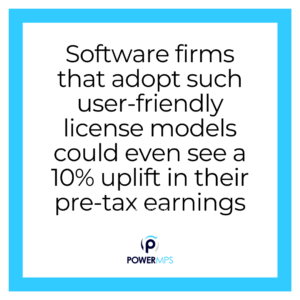
A winning card in the competitive business arena is undoubtedly an accommodating licensing model. It is of essence to understand that consumers value flexibility and freedom of choice in licensing. Research from McKinsey & Company indicates that software firms that adopt such user-friendly license models could even see a 10% uplift in their pre-tax earnings.
With increased autonomy, your clientele is more likely to favor your business over competitors. Therefore, incorporating adaptable licensing models that suit customer needs and preferences is not just an option, but imperative. Tailoring these models specifically to your vertical can give you an edge that could potentially transform your business, driving both consumer favorability and overall profitability.
Boosting Your Business with Industry-Specific Strategies
To truly leave competitors in the dust, building a comprehensive strategy that uniquely integrates these elements—technology, pricing, and licensing is vital. This approach must be carefully crafted to fit your distinct vertical. Begin by conducting a deep-dive analysis of your industry, grasping its subtle complexities and hurdles to ensure you comprehend the lay of the land.
At the core of your strategy, deploy these tools in a discerningly calibrated manner. The unique amalgamation of cutting-edge technology, strategic pricing, and adaptable licensing form a potent recipe that can not only give you a leg up in the competition but also position your brand as a top choice among consumers in your vertical.
The key is to steer away from scattered, appealing components and strive towards a holistic, industry-specific approach. Melding advanced technology, competitive pricing, and flexible licensing can ultimately culminate in a formidable business model agile enough to navigate the intricate maze of today’s business world.
To stay relevant in the rapidly advancing digital age, businesses must progress beyond simply adopting technology and revamp their strategies with industry-specific nuances. This approach should uniquely fuse technology, pricing, and licensing strategies into a robust, impactful model. Focusing on this amalgamation—designed concurrent with industry demands—can effectively boost your market stance, presenting a brand that resonates with customers and confidently navigates the evolving business landscape.
Cloud Use Rises: Secure Your Data Now
In today’s digitized world, businesses increasingly rely on the cloud for data storage. Statista reports that more than 50% of global enterprises were utilizing cloud services by the end of last year. However, this digital reliance also exposes businesses to potential cyber threats.
Cybersecurity breaches can be disastrous for businesses. The US National Cyber Security Alliance states that 60% of small and medium-sized enterprises that suffer a cybersecurity attack fail within six months. Thus, the protection of your business data becomes a crucial concern.
Transitioning to the Cloud
As we delve deeper into the digital era, cloud computing rapidly becomes the cornerstone of business operations. The unprecedented efficiency, scalability, and speed that cloud computing brings to the table are undeniable. Astonishingly, data from Flexera suggests that 94% of enterprises have experienced the advantages of cloud-based services.
However, making the shift to the cloud is not without its own set of challenges. Among these, the most prominent is the heightened need for effective cybersecurity. It’s a common mistake to treat traditional network security and cloud security in the same way. This misconception often leaves businesses exposed to severe digital threats.
Essentially, precautions and measures for cloud security differ significantly from those put in place for network security. Slight errors in understanding these variances can lead to irrevocable vulnerabilities in a company’s cybersecurity infrastructure. It’s imperative that businesses ascertain and adapt to these differences, ensuring maximum data protection.
Cybersecurity Measures in the Cloud
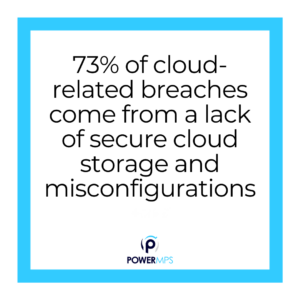
To effectively secure your business data, developing an agile security posture must be a top priority. Most cloud-related breaches, 73% to be precise, according to a report by Cloud Security Alliance, come from a lack of secure cloud storage and misconfigurations. Optimizing the configuration and management of access to your cloud resources is of pivotal importance.
In the realm of cybersecurity, it’s also crucial to establish and enforce in-depth, hands-on security practices. Such practices should include comprehensive audits, exhaustive penetration testing, and intensive training for all employees. Adding to the urgency, an alarming statistic from an IBM report states that 70% of cybersecurity breaches are attributable to insiders.
So, instilling a strongly rooted cybersecurity culture across the entirety of your organization is essential. This includes more than just setting up technological safeguards. Employees at all levels and in all departments should have a clear understanding of cybersecurity protocols and take an active role in implementing them.
Data Encryption and Backups
Undeniably, data encryption plays a vital role when it comes to securing sensitive business information in the cloud. Almost all cloud service providers offer encryption capabilities, but adding an extra layer of encryption can elevate the security of your data to a much higher standard.
On another front, data backups tend to be a commonly overlooked aspect of cybersecurity. Given their crucial role in ensuring business continuity in the face of unexpected cyber threats, they should be given more emphasis. Think of backups as a safety net for your data that can be activated when the worst happens.
Lastly, it’s worth noting a significant statistic from the Cybersecurity & Infrastructure Security Agency. They claim that 75% of ransomware attack victims who had regular data backups in place were able to minimize their losses significantly. In essence, maintaining regular data backups can be a relatively simple yet high-reward practice for protecting your business data.
Reliable Cloud Service Provider
The choice of your cloud service provider plays a significant role in securing your business data. When selecting a vendor, assessing their security regulations, their historical performance, and the control they provide over your data is crucial. Trusted service providers, like Amazon Web Services or Microsoft Azure, are known for strict adherence to privacy laws and offering robust protective measures.
Moreover, analyzing a provider’s breach notification policy deserves your careful consideration. How quick would they be to notify you in case of a cybersecurity breach? Quick detection and appropriate response can substantially reduce the damage a cyberattack can inflict.
To wrap up this section, it’s essential to understand that your cloud service provider is not just a vendor, but a partner. Such a partnership demands trust and transparency. Therefore, choosing a reliable cloud service provider is not just about comparing features and pricing. It’s about ensuring the best protection for your business data in a collaborative and mutual manner.
Final Thoughts on Cybersecurity
As we summarize our discussion on cybersecurity, it’s clear that shifting to the cloud is laden with both advantages and challenges. Cybersecurity undoubtedly stands at the forefront of these challenges. Therefore, vigilance to the evolving threat landscape and understanding the unique security needs of cloud services are critical.
In the selection of your cloud service provider, look for a reliable partner that aligns with your business’s cybersecurity needs. This goes a long way in enhancing the security of your business data.
Finally, let’s remember one crucial fact: In our digital era, data is king. Its protection should consequently be a top-tier priority for every business. Every effort invested in strengthening cybersecurity should be seen as safeguarding the lifeblood of your business.
Blueprint for the Next-Gen ERP Blueprint for the Next-Gen ERP
Blueprint for the Next-Gen ERP
Today’s digital marketplace is a constant swirl of evolution. Amidst this, enterprises are always hunting for innovative ways to retain a competitive edge and maintain profitability. Notably, the Enterprise Resource Planning (ERP) solution stands out in their digital toolkit. This tool has distinguished itself in enhancing operational processes. Simultaneously, it offers the potential to integrate and streamline various business operations, thus improving overall efficiency and profitability.
However, ERP adoption hasn’t been static. Instead, it’s experienced an impressive evolution over time. This is a result of persistent technological advancements and the ever-changing business needs that are shaping the modern world.
As businesses evolve, so does their perception of an ideal ERP solution. With this transition, the concept of a future-proof ERP has taken root. Presently, businesses are lining up the traits their ERP systems must embody. These are aimed at ensuring their adaptability to future business scenarios and maintaining their agility and responsiveness.
Accessibility from Anywhere
In today’s ever-evolving digital landscape, accessibility is not merely a luxury, but a necessity. Reflecting the rise of global business environments and an increase in remote work settings, ERP systems, too, have had to adapt. Bearing the future in mind, these systems now prioritize accessibility from anywhere.
Underscoring this trend, statistics published by the U.S. Census Bureau show that remote work has more than tripled since 2019. It’s a powerful testament to this new norm. Consequently, we now expect ERP systems to grant access to employees from an array of geographical locations, at any time, and on any device.
So, as we look to the future, accessibility has a profound impact on determining what constitutes a future-proof ERP solution. Enhancing accessibility ensures flexibility and business continuity – two valuable attributes in the volatile, high-paced business world of today.
100% In The Cloud
As we traverse into the digital era, cloud technology has emerged as a game changer for many business operations. The way businesses manage their resources and processes is increasingly shifting towards the cloud, propelling ERP solutions to be entirely cloud-based to remain competitive.
A report from Fortune Business Insights predicts that the global public cloud market will reach an impressive $677.95 by 2024, a clear testimony to the massive role of cloud technology in shaping future business strategies. Rather than confining themselves to traditional models, businesses are increasingly looking for ERPs that offer the flexibility, scalability, and cost-effectiveness intrinsic to cloud-based solutions.
A Break From “Per User” Pricing
In the era of customization, conventional “per user” ERP pricing feels obsolete. Transitioning to our present model, businesses are experiencing a significant shift in ERP pricing strategies.
Now, enterprises prefer models that favor flexibility and scalability. Breaking away from the customary “per user” pricing is the new trend. This deviation aligns with the IDC forecast, which projects a change toward usage-based pricing in ERP solutions.
Consequently, this model mirrors the actual system usage. This allows businesses to adapt their systems according to growth, needs, and budgets. Shifting away from “per user” pricing, we align costs with business value. This changes the perception of ERP solutions from financial burdens to strategic investments. Ultimately, this approach aids in making the ERP system chosen today a beneficial asset for tomorrow’s businesses.
Ownership of Data
Data ownership has become an essential consideration for businesses in this data-driven age. One of the pillars of a future-proof ERP is ensuring that data ownership and control rests in the hands of the business itself.
As data breaches continue to surge, managing the information that an ERP system can access is vital for maintaining business integrity and customer trust. By ensuring businesses retain ownership of their data, ERPs can promote better security and privacy. This becomes especially beneficial when dealing with sensitive information, allowing businesses to remain in control of their data governance strategies, thus shaping a truly future-proof ERP.
No-Code or Low-Code
 In the ever-evolving landscape of ERP solutions, simplifying the process of customization has become a focal point. The future of ERP seems headed towards no-code or low-code platforms, making it significantly user-friendly.
In the ever-evolving landscape of ERP solutions, simplifying the process of customization has become a focal point. The future of ERP seems headed towards no-code or low-code platforms, making it significantly user-friendly.
A forecast by Gartner highlights the influence of low-code in the future of application development, predicting that it will account for 65% of all application development by 2024. These platforms are designed to accommodate users with minimal coding experience. Therefore, every business user can tailor the ERP system to the changing company requirements, even without an extensive IT background.
Consequently, this means faster deployment of new features and less reliance on IT teams. Companies save time and resources, driving efficiency and productivity. With these low-code or no-code ERP systems, organizations can keep pace with the swift business process and strategy changes. Essentially, they are the key ingredient for creating a future-proof ERP system.
A future-proof ERP would embrace the emerging shifts in the workplace, embody flexibility, enhance data privacy, and expedite application development. Businesses must carefully select ERP solutions with features that align with these future demands to ensure they’ve invested in a system designed for longevity.
Lear more about ERP here
Cost Reduction to Amplify Profit Margins
Boosting profits is an enduring pursuit of businesses worldwide, spanning industries from retail to tech. Yet, traditional approaches often overemphasize the role of revenue generation, leaving a crucial lever – cost reduction – under-explored and underutilized.
In the tech industry, this untapped cost containment potential is particularly profound. Rapid advancements within technology provide unique opportunities to streamline operations, eliminate waste, and enhance profits swiftly. This post unveils how tech corporations can effectively batten down costs, all while riding the tide of technological innovation, to drive a quick and substantial increase in their profits.
Understanding the Profit Equation
It’s conventional knowledge, as Investopedia explains, that profit equals revenue minus costs. This equation is critical to the anatomy of any business’s financial health.
Typically, profitability enhancement strategies focus on the revenue side – strategies that could range from marketing enhancements to product line expansions and scaling operations. These are certainly viable strategies, but they tend to overlook a more immediate avenue for profit augmentation – cost reduction.
More importantly, cost reduction holds a crucial place in the dynamic world of technology, where the pace of change sets up a unique set of opportunities. McKinsey states that technology companies can improve their EBITDA (Earnings Before Interest, Taxes, Depreciation, and Amortization) margin by 1 to 3% by acting on cost efficiencies. Therefore, tech businesses must pay equal attention to cost management for a steady and rapid increase in profit.
The Power of Technology in Cost Reduction
In its transformative capacity, technology is a potent cost-reduction agent. Accenture’s report reveals that a significant 63% of high-performance businesses stress technology investments to refine their cost structures. Given such emphasis, it is clear that technology harnesses a multitude of avenues to drive down costs.
One such avenue is through automation. By automating repetitive tasks, businesses can minimize workforce costs, expedite processes, and simultaneously enhance customer satisfaction. Increasing automation leads to a dual benefit of reducing expenditure and growing revenues. Furthermore, Gartner foretells that by 2025, robotic process automation (RPA) will have achieved near-universal adoption. This fast-gaining momentum indicates the cost savings potential inherent in automation.
The utilization of software and hardware can also be optimized for further cost-saving. An efficient system reduces downtime and prevents over-provisioning of resources; this balancing act cuts costs and heightens operational efficacy. By embracing technology, businesses can morph their cost structures into leaner, more efficient models.
Making the Move to Cloud
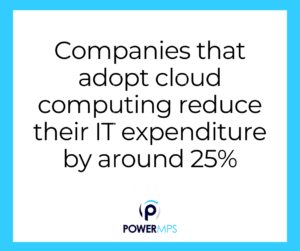
Moving to cloud computing stands as a powerful tool for tech businesses in their pursuit of cost reduction. TechJury affirms this by noting, “Companies that adopt cloud computing reduce their IT expenditure by around 25%”. The reason for this is the unique advantages offered by the cloud model.
Cloud computing lets companies transition away from expensive on-premise hardware and software. This shift reduces investment, maintenance, and upgrade costs, significantly impacting the bottom line. The scalable nature of cloud computing also means businesses only pay for what they need and use, preventing resource wastage. Moreover, according to a report by LogicMonitor, 66% of IT professionals state that security is their primary concern when adopting an enterprise cloud computing strategy. It’s essential, therefore, that companies not only manage costs but also pay heed to secure their data while migrating to the cloud to ensure balanced and long-term success.
Navigating the Balance for Success
In wrapping up, the intricate balance between cost reduction and strategic investment emerges as a centerpiece for successful profit maximization, particularly within the tech sector. Trimming costs must not come at the sacrifice of quality and value delivered to customers. It’s, therefore, essential to conduct cost reduction initiatives strategically to avoid potential pitfalls.
The continuous march of technological progress is revolutionizing the discourse on cost management. A forward-looking approach embracing these advancements is vital for businesses aiming to amplify their profit margins swiftly. Farsighted investment in technologies now can unfurl significant cost reductions tomorrow, creating a more efficient, lean, and ultimately profitable enterprise.
The numbers, such as the impressive adoption rates of cloud computing and automation, underscore the impact of technology on cost reduction. Thus, keeping a pulse on emerging technologies, understanding their implications, and deploying them strategically is the fundamental equation for maximizing profitability in the tech industry. Harnessing technology’s cost-cutting power can pave the way for a more profitable tomorrow.
Scaling Your Office Tech Business: Customer Centricity
Scaling Your Office Tech Business: Customer Centricity
The path to scaling any business, especially in office technology, is fraught with challenges. Navigating these needs a strategic compass, a ‘secret’ if you will. A key finding from a Deloitte study proposes this secret: Align your business models and processes around the customer. This seamless integration of customer-centricity into your business structure is crucial for sustainable growth.
A Vital Need to Maintain Customer Centricity
Understanding why successful companies emphasize customer-centric approaches is crucial in defining a well-thought-out business strategy. The answer lies intricately woven into the tapestry of evolving customer expectations. Treating your customers as the heart of your operations isn’t just necessary; it’s an absolute growth catalyst.
As your business scales, so do customers’ expectations. They grow synonymous with your expansion, creating an advancing bar businesses must meet to clinch satisfaction. This relationship is a testament to the influence of three critical tenets of trust:
- Providing consistent, exceptional customer care: Evidence suggests that businesses offering superior and consistent customer service retain more customers in the long haul.
- Offering leading-edge technology and support: Using cutting-edge technology and delivering timely support becomes instrumental as customer expectations develop.
- Designing business processes and models with their needs in mind: The business models and processes should be designed to consider the customer’s evolving needs.
The Need for Superior Customer Service
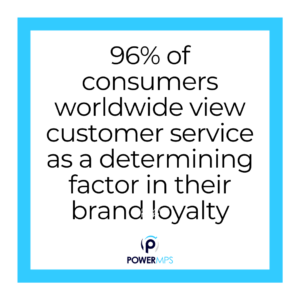
Superior customer service is no longer just a bonus—it’s a necessity. It is the driving force behind customer retention and loyalty. According to a survey by Microsoft, a staggering 96% of consumers worldwide view customer service as a determining factor in their brand loyalty. This statistic drives home the importance of meeting and surpassing customer service expectations.
Customer service is more than just well-trained representatives— it extends to all consumer interactions with your operations. From the moment they engage with your company, whether it’s a phone call, email, or chatbot interaction, your customers should feel valued and appreciated. This mindfulness to customer engagement establishes your organization as one that consumers can trust.
Refining your customer service isn’t just an investment in the present—it’s a strategy for long-term success. By ensuring that every touchpoint with your customers is outstanding, you provide a customer experience that differentiates your brand in a saturated market.
Pivoting Business Processes to the Digital Age
In today’s dynamic business landscape, technology plays a monumental role in satisfying customer’s expectations. As businesses expand and scale, consumers expect the companies they engage with to offer cutting-edge solutions that simplify their interactions. A PWC report highlights that an impressive 85% of buyers are willing to pay a higher price for a superior customer experience, including seamless access to the latest technology.
This trend stresses the need for businesses to stay abreast of emerging trends and innovations, especially in the office technology sector. Companies should focus on incorporating these advancements in their product or service offerings. Their experience with your technology shapes your customers’ perception of your business. In essence, maintaining an innovative edge isn’t just about staying ahead of your competitors, but about meeting your customers’ rapidly evolving needs and expectations.
Keeping Customers as the Core of Your Business Processes
The foundational component of customer-centricity is integrating customer needs into your business operations and processes. Continually reassessing your business models to reflect your customer’s evolving needs is crucial.
With this approach, clients feel valued and understood. They become confident that their needs are prioritized and addressed effectively. This perpetuates trust and nurtures an enduring relationship, bringing about customer loyalty, referrals, and an unbeatable competitive edge. The suitable business model and an unswerving customer focus can catapult your organization to sustained growth and success.
Customer Centricity: The Crux of Scaling
Customer-centricity is not a fleeting business trend—it is the powerful engine propelling the most resilient companies in today’s volatile landscape. Figures from Deloitte underscore this, showing that businesses prioritizing their customers are 60% more profitable than their counterparts.
A robust, customer-focused approach is the underlying strategy for successful, sustainable scaling. The increasing demand for personalized experiences means companies must listen carefully to their customers and adapt accordingly. This adaptability is essential in the secret to scaling any office technology business—an accurate customer-first approach.
Evolving with your Customers
In the journey of business evolution, aligning your pace with that of your customer’s expectations is paramount. As your organization develops and scales, so do your customer’s needs and requirements. Companies must adopt a proactive approach to identifying and acting upon these changing needs to keep up with this progression.
This is where a steadfast focus on customer centricity comes in. Upholding a customer-first approach ensures that your business is ready and equipped to meet escalating customer expectations. By doing so, you promote a positive customer experience and create a sustainable business model that drives successful scaling.
The secret to scaling your office technology business lies in providing exceptional customer service and technology and realizing that your customers are at the heart of your business. Ensuring that your business models, technology, and processes are centered on their needs will help your business seamlessly scale and maintain a competitive edge.
How AI and Automation Can Save Your Business Money
How AI and Automation Can Save Your Business Money
Embracing artificial intelligence (AI) and automation is more than just a tech trend—it’s a strategic move that’s revolutionizing cost structures and resource allocation in businesses. As technologies advance, AI and automation demonstrate their potential to streamline processes, enhance efficiency, and allow customization in novel ways.
Saving Time Through Process Streamlining
AI and automation can reap substantial time savings by streamlining repetitive manual processes. Consider service calls – AI-powered chatbots handle basic customer queries without human agents, allowing them to focus on complex issues. Similarly, back-office tasks like PO processing and OCR of paper payments that once sucked up valuable worker hours are now automated.
A 2020 PwC study found over 50% of large global enterprises reported significant time savings through back-office automation. These automated document workflows cut processing times from weeks to hours for many companies. One insurance provider reduced claim processing by digitizing paperwork from 12 days to just three.
Freed from tedious administrative busywork, employees have time for high-impact strategic duties. Automating such rote tasks boosts productivity across organizations—one marketing agency automated contract generation, paring the process from days to under an hour. Employees refocused on new business pitches and saw proposal win rates surge by 25%. Offloading grunt work through streamlined digital processes unleashes massive productivity gains and labor cost reductions.
Enhancing Efficiency Through Intelligent Automation
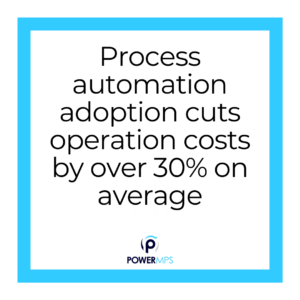
AI and automation enhance efficiency by performing tasks with superhuman capabilities. Advanced machine learning algorithms can rapidly analyze vast amounts of customer data, identifying patterns and trends that would be impossible for humans to detect. This augmented intelligence boosts marketing, customer service, and product development functions.
For example, algorithms can scan terabytes of customer purchase histories within seconds, uncovering purchasing habits and preferences. Marketers can leverage these insights to develop hyper-targeted campaigns. According to IBM, a single algorithm uncovered $300 million in additional annual revenue for one retailer.
Robotic process automation (RPA) provides another avenue for dramatic efficiency gains. RPAs emulate human actions to complete repetitive rules-based tasks around the clock. A survey by UI Path found RPA adoption cutting operation costs by over 30% on average in early adopting companies: Bots process invoices, data entry, and forms at superhuman speeds with perfect accuracy. One insurance company accelerated claims processing from weeks to days using RPA, improving the customer experience.
Allowing Flexible Process Customization
AI and automation also bring the advantage of adapting processes on the fly. With intelligent systems in place, workflows, and business logic can be tweaked easily through configuration instead of code. This allows non-technical staff to easily incorporate new rules, exceptions, and scenarios based on changing needs.
Consider how AI chatbots or RPA bots can be taught new responses, linked to different systems, or optimized to address atypical cases—all without reprogramming. The flexibility makes processes future-proof and continuously improving. As Robotic Process Automation Netherlands found, over 75% of responding enterprises report reductions in IT maintenance costs after deploying automation platforms for this reason[3].
Aligning AI with Business Strategy is Key
Appropriately directing AI initiatives requires aligning them with organizational goals and strategy. Leaders must thoughtfully determine how AI can augment competitive positioning and value propositions. Without this human element providing guidance, even the most advanced systems will lack focus.
The first step is assessing where AI can generate the most impact. A manufacturing firm aiming to cut costs and boost output might prioritize automating capital-intensive production processes. On the other hand, a consulting business focused on innovation could leverage AI for advanced data analytics and improving client-facing solutions. Performing a strategic review of core strengths and weaknesses helps identify optimal initial targets.
Equally important is establishing governance around AI projects. Clear ownership and oversight ensure technologies continually serve strategic objectives as they evolve. Periodic reviews check alignment and allow pivoting investments where needed. AI must flexibly support reshaping business models over time. Otherwise, there is a risk benefits fail to materialize or automation undermines human aspects critical for success. Strategic direction is what unlocks AI’s full potential value.
Measuring Impact and Continued Optimization
To truly maximize ROI, it is important that companies establish clear metrics for tracking AI and automation impact over time. Key performance indicators could include labor hours saved per project, reduced error rates, customer satisfaction gains, or increased revenue from improved processes. Benchmarking baseline performance allows quantifying improvements and refining strategies based on data.
Leading organizations also view AI implementation as an ongoing optimization process rather than a one-time project. As technologies and use cases advance, so too must the alignment of these systems with evolving core capabilities and operational needs. A flexible, metrics-driven approach keeps automation working hardest for the business on a continuous basis.
When embedded thoughtfully into strategic planning and enabled by the human element, AI and automation fundamentally have immense potential to alter cost structures for forward-thinking companies fundamentally. Proper execution can deliver time savings, efficiency boosts, and process flexibility that few other innovations rival. At the same time, the journey requires investment and discipline; the payoffs of streamlining mundane tasks through intelligent systems open new growth opportunities.
Transitioning Your Managed Print From Products To Services
For decades, office printer services have had one primary focus, selling products. Toner, ink, and paper were the main commodities. But the introduction of the world-wide-web has forever changed that business model.
The World Goes Digital
Today, printer services deal with a decreasing demand for print as more companies work toward a lofty (and arguably unattainable) “paperless workplace” goal. Organizations are eschewing faxes and scanning for software like DocuSign, Evernote, and Google Drive. These businesses encourage saving essential emails to PDF rather than printing them out and storing them in physical files.
But, it’s more than just a move toward paperless offices. It is human behavior. We are being trained more and more to “buy online.” The impetus being that we can get it more conveniently. And, perhaps more importantly, we can compare multiple prices. The goal, of course, is to source things cheaper. These businesses want to save money. That drive to reduce costs means printing services providers must contend with big-name online stores like Amazon, Newegg, and eBay for everything from paper to ink and even cartridge recycling.
Changing The Narrative
It might be time to rethink your business model. Printer services are so much more than an ink and toner dealer. They offer a wide range of additional benefits, including high-volume, networkable printers, maintenance, service, and, yes, the consumables required to keep things running.
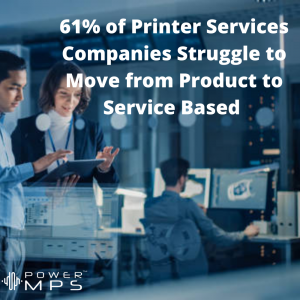
So, what is stopping Managed Print Services (MPS) from emphasizing the “service” over the consumable? Over half (61%) of printer services companies say they are having difficulty making this move, possibly because it feels almost like a bate and switch.
In a product sales model, your view and the client’s view of the sale are the same. They are purchasing a product (ink, toner, paper, printers, and maintenance contract) for which you will charge them.
When you sell MPS as a service, the conversation with the client and internally is from two completely different angles. What you are selling and charging for is the convenience of printer placement, operation, maintenance, and provision of consumables.
Essentially, the move to “service” versus “product” is all about mindset. It’s no longer about what you can physically sell the customer. Instead, it’s how the things you traditionally sold can be put together to resolve problems your customers are facing.
Taking The First Steps
The first move to make when you begin to transition from product sales to a service organization is to outline your approach. Some key questions that can help you get started include:
- What are your clients’ goals when it comes to printing? Are they seeking to limit their print volumes, expand to multiple offices, cut costs, or lower their office footprint?
- Would your customer spend to handle print services on their own?
- Are there any “hidden costs” associated with print management, such as cybersecurity, etc.?
- What are issues your MPS regularly encounters that customers might not know how to handle?
- What other problems can your specific products and services help address? Energy use? Recycling? Division of labor? Use of physical space? Paper usage?
The goal is to figure out exactly what problems your current clients and target audience have that your business can solve. Things like cutting back-office costs, better cybersecurity, and preparing for hybrid and remote-work organizations are areas in which MPS providers can provide unique solutions and help businesses thrive. Managed print services also have better knowledge and access to printing solutions that help reduce office footprint, focus on internal networking, and more longevity.
Bundling Service Packages
Once you have a strategy in mind, it’s time to build out “service packages” and “service add-ons.” These bundles should cover the costs they would incur to your business. However, website wording and promotional materials should focus on highlighting the benefits and estimated savings of partnering with an MPS.
Businesses using systems like PowerMPS, for instance, could talk about printer performance reporting, predictive or subscription consumables reordering, and online service and maintenance requests. All of these options services help partners target specific pains within their business, such as:
- Reducing wasteful printing.
- Decreasing spend on ink, toner, and paper.
- Reducing inventory space needed for printing consumables.
- Improving service and maintenance response times.
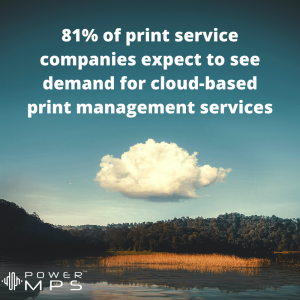
Other standard perks could include friendly online or phone-call trouble-shooting, ink and toner recycling, or additional data-driven cost savings recommendations. But, don’t forget how the world is becoming ever more enamored of self-service portals, mobile applications, and 24/7 access. In addition, the majority (81% ) of print service companies expect to see demand for cloud-based print management grow in the next few years. Therefore, investing in a customized website and customer portal for faster and always available access to ordering, service, and bonus features is highly recommended.
As the world becomes more and more digital, MPS businesses cannot begin their journey from product to service too soon. So, whether your organization is struggling with the transition or just getting started, remember to start where your sales team has always begun – talking to current and potential customers. Their needs, problems, and stories are the perfect foundation for building your future in printing services.
Cultivating A Digital Mindset In The Office Printer Industry
Cultivating A Digital Mindset In The Office Printer Industry
The past year and a half has seen e-commerce become more than a shopping option for consumers. It is now a habit. Online sales spiked during the 2020 pandemic. But even six months later, digital sales remain much higher than before. E-commerce has exhibited nearly two decades’ worth of growth since 2019, according to a 2020 US Ecommerce Market Report.
And online purchasing habits affect more than consumer retail. Interactions throughout the past eighteen months have trained even business purchasers to search online first. So, how can Managed Print Service (MPS) providers survive in a world that is edging more and more into online retail? By shifting business strategies to embrace both the traditional and the digital.
One Small Step For MPS
Businesses that fail at digital adoption usually fall into two buckets – those who refused to embrace change and those who jump in without testing the waters. What ink, toner, and office printing service businesses must understand is that digital transformation is a long-term strategy. Therefore, implementation requires much more than a laissez-faire attitude.
A robust digital plan will include an evaluation of company goals, target audiences, and a thorough analysis of competitors and clients. For example, why do customers seek your products and services? Why do some businesses go elsewhere for MPS? What differentiates your business from others? What kind of experience do you want to represent your company?
Once goals, targets, and vision are set, it is time to map out implementation. This is where you decide how your MPS business will host a website, manage digital communications, and integrate these digital aspects into your existing sales and customer service. Again, there is nothing wrong with having an extended timeline to allow your business the opportunity to fully integrate each change before tackling the next step in the digital transformation process.
Communication Has Changed

No one picks up the phone anymore. No, really. Nearly 90% of US adults ignore phone calls. Why? Because most of the time, when the phone rings, it isn’t someone you know. Despite efforts from the Federal Communications Commission, robotic calls, or robocalls, have nearly tripled in the past decade to over 3 Billion calls per month. People’s work phone numbers are not exempt.
So, how are people communicating if not by phone? Just like everywhere else, they have gone digital. Buyers are looking for their information online through search engines, email, and social media. The good news is this gives managed print services an excellent opportunity to showcase their businesses. Websites, emails and social allow the office printer industry to highlight their benefits in ways that directly correlate to the needs and preferences of their target audience.
Nearly half (47%) of buyers report having viewed 3-5 pieces of content before they ever contact a sales representative. Popularly viewed content includes product and service features, comparison guides, benefits highlights, infographics, white papers, and interesting statistics. When posted on a company’s website, emailed out, and highlighted in social media feeds, this content helps position the business and its salespeople as reliable, responsive experts in the industry.
Sales Is Social
Like the phone call, cold call sales are pretty much dead. Recent studies show this tactic now provides a bare 0.3% success rate. Social media, however, is helping to create new sales leaders. Over three-quarters of salespeople who use social media regularly outsell their peers. Social users are also more likely (23%) to exceed sales quotas.
Rather than cold outreach, these salespeople build up professional networks on platforms like LinkedIn using engaging content, commentary, and conversation. Then they use these networks to gather insights and intelligence – targeting key decision-makers.
A majority (92%) of buyers who are active on social are willing to engage with those considered thought-leaders or experts in the industry. Over half (62%) are eager to speak directly with salespeople. MPS companies who encourage their salespeople to use company-generated content to sell on social are setting themselves up for future success in today’s e-commerce economy.
Karen Said It Works
People talk. But, more importantly, people listen. Most consumers purchase products based on recommendations from friends, family, and acquaintances. But, just like general e-commerce, this behavior is not limited to consumer retail. Over 80% of business-to-business buyers begin their search with a referral.
In this new digital age, where service is a significant differentiator, managed print services, toner, and ink providers should have a strategy for managing their reviews. And that management should be more than putting out fires when things go wrong. Print businesses should actively ask for reviews for their Google Business page, to post on their website, and to highlight on their social media platforms. Great relationships can lead to great content and a good boost in business.
Getting Started
The most critical beginner tools for taking your Managed Print Services business into the digital world include a high-performing, responsive website and an email marketing kit. In addition, your business website will serve as your hub for initial brand introduction and content hosting.
The best programs will also go above and beyond the basics. Savvy businesses will be sure to partner with platforms that offer what they need to fit their ongoing digital transformation strategy. For example, systems like PowerMPS provide easy-to-use customizable websites and a complete email marketing campaign management system as well as the order and service management, reporting, accounting tools, and other programs most MPS businesses need to find digital success.
The Office Print Industry, A Platform Economy Service?
The Office Print Industry, A Platform Economy Service?
Do you remember when a platform was a place from which you caught a train, subway, or bus? Of course, today’s growing digital economy has since co-opted the word. But, deep down, the meaning remains the same – a location from which you connect to another person or place. Now, however, those connections exist in cyberspace.
The new digital platform is an environment in which a piece of software is executed. Today’s most common platforms are a set of stable components that allow for various other functionality and connections with other components. For instance, an operating system like Windows 10 and web browsers like Chrome or Microsoft Edge are platforms. So are Zoom, Skype, eBay, and Etsy. Or, more simply, a platform is a system that makes it easier for you to do other things.
At the end of the day, platforms are disrupting nearly every industry across the globe, and as you will see, that includes the office printing space as well! Are you prepared for the digital disruption that is occurring within managed print?
How Software Platforms Began
Disk Operating System, or DOS, is the program without which a personal computer cannot run. Though the terms “platform” and “platform economy” may be new, digital platforms have been around since the development of the computer. As personal computers picked up popularity, more user-friendly operating systems such as Microsoft Windows, Mac OS, and Linux were developed. From there, we began to see word processing, finance, and artistic platforms such as Microsoft Word, Quicken, and Adobe Photoshop.
The development of the worldwide web saw an even more comprehensive array of software platforms. Things like America Online (AOL) and CompuServe allowed people to access and interact with other internet users and rudimentary website pages. Then came the early nineties. Referred to as the “DotCom” era, this period was a hotbed of digital platform development. The nineties brought Prodigy, a CompuServe competitor, along with chat service competitors such as AIM, Yahoo Messenger, and ICQ. In 1995 the first internet search system, AltaVista, was launched, followed by the first social media platform, GeoCities.
While most platforms and websites developed during the DotCom boom have fallen by the wayside, some of these ventures now claim spots among the top five largest US companies. Giants such as Google and Amazon were created during this era. And with them, the age of the platform economy was born.
Platforms Disrupting Industries
As internet software has progressed, platforms have begun to shift into distinctive categories. The most common are also the most disruptive, those providing retail and services. Popular retail platforms include the likes of Amazon, eBay, and Etsy. These popular online retailers have pushed larger physical stores such as Walmart and Target to create their own robust online offerings. But they have also destroyed many smaller retailers who have difficulty maintaining the inventory on internet clout to attract digital customers and sell online.
Similarly, service platforms have shaken up several major industries. Perhaps the most notable are taxis, public transportation, and hotels. Where once a taxi, bus, or commuter train were primary ways to get places, now it is common to “call” an Uber or Lyft. Hotels have suffered a similar fate as Airbnb allows smaller, independent owners to rent out rooms, condos, and homes to travelers at rates that often rival those found for the typical inn.
Today these platforms have gone beyond traditional disruption. In their bid for continued growth, they have begun to cannibalize portions of other industries – including Managed Printer Services. Big names in the printer industry, like HP, are already working to offer online service and maintenance scheduling. Other unrelated businesses such as Amazon and eBay offer a variety of inks, toners, and parts at often ridiculously low prices.
But industries like retail, service, and even managed print services (MPS) don’t need to sit by and watch their businesses get gobbled up. Because the platform economy has grown so much, there are now programs that provide online tools and support to help companies create their own platforms — services like PowerMPS.
Competing At The Platform Level
Becoming a platform changes the rules of engagement, even in the printing industry. For MPS providers, it often means changing the game on how your company conducts business. Some companies may continue to prefer the brick-and-mortar store and in-person or over-the-phone sales and service relationship. But a growing number of businesses are beginning to prefer browsing online inventories, as-needed or predictive subscription ordering, and online chat and scheduling for service and maintenance. Group these robust interactions with in-depth office printer and copier use and consumables volume reports, and regular platform users have an experience they will grow to love. In fact, they will rely on it!
MPS providers using services like PowerMPS can couple retail and service platforms into one customized e-commerce storefront and service platform. With such a powerful tool, it is easy to keep up with current clients while leveraging the platform to help increase reach to new, more digitally-focused customers.
The platform economy has been steadily expanding and disrupting traditional retail and service spaces for over three decades. Fortunately, new technologies allow even those unfamiliar with e-commerce to build their businesses into online platforms. Tools such as reporting, service scheduling, email marketing, digital storefronts, and more will be the foundation that can support current business while giving these companies a digital mooring for growth well into the future.
Learn more about how PowerMPS can help your Dealership increase profits and services
The Answer To The Financial Print Dilemma – Managed Print Services
Data has always been essential to running a business, especially when it comes to the financial side of a company. Tracking materials usage and time spent on projects or tasks has always been a struggle for accounting departments. However, Big Data has made it much easier to set up programs and systems to assist in tracking items essential to fully developed financials.
The beginning of this type of tracking was embedded in the use of firewalls and servers. IT used these tools to block access to websites and services that were deemed unsafe or distracting. It also helped keep tabs on what and how employees were using their time and equipment.
Now, however, with an ever-growing remote-work environment, companies are moving beyond the standard in-house tracking. Instead, they are beginning to implement project management software like Monday. More intensive clock-in and clock-out tracking systems like Toggl are also a common alternative. However, businesses with significant security concerns and stringent compliance or regulatory requirements have begun to migrate to all-in-one screenshots, website usage, and time-tracking systems—programs like Time Doctor or Clockify. But, no matter the software or methods being used, businesses can now fully monitor and track the work and time of each of their internal and remote workers.
For finance departments, the introduction of these systems means easier tracking and categorizing of employee time. It helps them tabulate hours spent on individual projects and apply costs to specific areas throughout the business. However, despite more advanced tracking capabilities in the realm of the employee, there are back-office and overhead expenses that are still tough to trace, such as printing.
The Printing Expense Dilemma
Many may argue that printing costs are very easy to tabulate. But printing industry experts such as Managed Print Services providers know the actual costs of printing go far beyond the equipment and supplies. How much a company pays to purchase or lease a printer or spends on paper and toner are only the surface expenditures.
The truth is that, for every $1 spent on office printing, another $9 is paid to manage it. This expense is created by IT management, infrastructure, and support. While the Information Technology (IT) group may lump print in with the rest of their general office assistance and structure, analysis proves it takes up far more time and energy than anyone would like to believe. Most businesses report 40% of their help desk calls and tickets are print-related when thoroughly evaluated. And these ongoing print problems can require anything from basic assistance such as supply replenishment or jam assistance to a repair call.
But IT is not the only department affected by office print management. Equipment, toner, ink, and paper supplies all fall on the administrative and procurement departments. Ensuring these items are appropriately sourced in a timely manager often requires inventory regulation. Larger offices may even require regular reports on print dispense and ink levels. In some cases, this information may involve direct contact and inspection of the print equipment’s stored data.
Add to all of this the need to provision and upkeep on-site (and now remote and at-home) printing facilities; it does not seem unreasonable for print management to encompass such a staggering hidden cost. Yet nearly half (40%) of North American businesses cannot accurately track print and print management expenses. As a result, most companies spend a great deal more than they should to provide these services to their employees. A typical business spends up to 3% of its annual revenues on office print services.
Managed Print Services – Solution To Print Costs
Seeing such a cost analysis, finance departments might immediately attempt to steer their company toward a paperless environment. Indeed, many organizations have been working hard toward the vision of a completely digital office. But studies have shown paper is still an essential feature for employees and security. Fortunately, there are ways for businesses to provide finance with the data attributions they desire while significantly lowering the overall costs of business office print.
Managed print service (MPS) providers consolidate administration, printer helpdesk, and maintenance into one package. As a business that is wholly focused on providing printer services, equipment, and supplies, they can leverage their industry knowledge, experience, and volumes to help reduce wait times, resolve issues, and lower supply costs. Overall, MPS services can reduce overall printing costs by up to 30%. The cost-savings to print-related helpdesk tickets and calls alone range from 7-14%.
MPS providers using business process automation systems like PowerMPS offer even more data and cost savings. These platforms provide MPS customers with easily accessible data on print volumes by printer, location, and current supply levels. This information can be accessed from the comfort and safety of the home office – for even remote office and connected desktop printers.
MPS using PowerMPS systems can provide an in-depth look at supply usage for those finance departments demanding even more convenience and cost savings. And there are ample time savings with predictive supply ordering technology and online maintenance management.
Finance departments in businesses across North America might be at a disadvantage for tracking and understanding their actual office printing spend. But, just like there is a growing service and software space for proper employee time management and attribution, there are solutions for the enterprising finance team. When it comes to tracking and management for print, these companies should take a hard look at partnering with a reputable MPS provider – especially one galvanized by an authoritative tool such as PowerMPS.
Redefining Workspaces: The Role of Wellness Zones
Redefining Workspaces: The Role of Wellness Zones
Creating a positive and healthy work environment is essential for employee well-being and productivity. In recent years, especially since the pandemic, businesses have recognized the importance of incorporating wellness spaces into the workplace. These dedicated areas provide employees with opportunities to relax, recharge, and prioritize their physical and mental health.
In today’s brisk work environment, employees’ mental health should be the top priority of organizations. After all, a happy employee is a productive employee. As businesses strive to create a positive and productive work culture, incorporating wellness spaces into the office has become a prevalent trend.
The Rise of Wellness Spaces
In the late 1980s, companies focused on psychological well-being as part of their workplace wellness initiatives. In pop culture, these efforts were fueled by the popularity of an exercise video series released by Jane Fonda at the start of the decade.
Workforce wellness grew in popularity at that time due to diminished employee loyalty, resulting from tumultuous economic issues and distrust in corporations. Employees started protecting their own needs in comparison to the wants of their employer. In 1986, OSH began to encourage implementing stress-related mental health programs in the workplace.
By the new millennium, workplace wellness programs were fairly established domestically. A 2008 Employer Health Benefits Survey reported 70% of large companies in America had workplace wellness programs. It also helps that global businesses are experiencing drastic innovation due to technological advances.
The Current Landscape
As we continue the second decade of the 21st century, the workplace wellness journey has gone full steam ahead, increasing awareness and prevention services. Today’s workplace wellness programs are designed primarily as preventative care for innumerable health conditions.
Screenings and health risk assessments accurately detect acute and chronic conditions. Mental and emotional health services have been emphasized with increased absenteeism due to the global pandemic. Teams of clinical and non-clinical practitioners include mental, behavioral, and integrative health working in partnership with health, wellness, and professional recovery coaches. Because of the isolation of 2020, the need for mental and behavioral health services has never been more prevalent. So has an increased want of wellness spaces in the workplace.
The Impact of Wellness Spaces on Employee Health
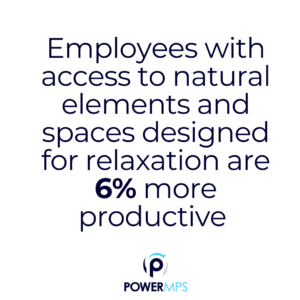
Research shows that incorporating wellness spaces into the office can significantly impact employee health. According to a study by the World Green Building Council, employees with access to natural elements and spaces designed for relaxation and rejuvenation experience a 15% increase in well-being and are 6% more productive. Furthermore, according to Gallup, engaged employees are 21% more productive than their disengaged counterparts.
Understanding the connection between employee happiness and overall organizational health is vital. By providing areas for physical activity, quiet reflection, or even a quick power nap, employers can help reduce stress, boost mental clarity, and improve overall employee health.
Designing Relaxation Zones
Creating dedicated relaxation zones within the office environment can offer employees a retreat from the demands of their workday. These spaces can be designed with comfortable seating, soothing lighting, and calming elements such as plants or water features.
For example, Google has incorporated nap pods in their offices, providing employees with a quiet space to recharge. Additionally, Salesforce has installed meditation rooms in their offices, recognizing the importance of mental well-being in achieving optimal performance. Employees can take short breaks to relax and return to their tasks feeling refreshed and rejuvenated by designating specific areas for relaxation.
Incorporate natural elements like plants and natural light to create a calming environment. Provide ergonomic furniture and adjustable workstations to promote good posture and reduce the risk of musculoskeletal issues.
Prioritizing Physical Activity
Encouraging physical activity at work is vital for maintaining employee well-being. Many forward-thinking companies have implemented on-site fitness facilities or designated exercise areas within their office spaces. These spaces are equipped with exercise equipment, such as dumbbells, treadmills, or yoga mats.
For instance, Zappos and USAA offer an on-site gym and organize employee group exercise classes. Regular physical activity improves physical health, increases energy levels, reduces stress, and enhances cognitive function. Fitbit reports that employees who engage in physical activity during the workday have 53.8% lower healthcare costs.
Embracing Nature & Biophilic Design
Biophilic design, which incorporates elements of nature into the workplace, has gained popularity for its positive impact on employee well-being. Natural light, indoor plants, and views of green spaces have been shown to reduce stress, enhance mood, and improve productivity. Amazon’s Spheres, a collection of glass domes filled with plants, exemplifies this approach. By integrating nature-inspired elements, employers can connect with the outdoors and promote a sense of calm and serenity in the workplace.
Supporting Mental Health
As mentioned earlier, promoting mental health is the most important aspect of improving employee well-being. Organizations can foster a positive work environment by destigmatizing mental health and offering support. Companies must foster a supportive culture outside of wellness spaces that encourage employees to utilize these amenities. Managers should all lead by example, emphasizing the importance of work-life balance and wellness practices. Offering flexible work arrangements, promoting regular breaks, and providing access to mental health resources can further this initiative.
Learn more about PowerMPS and their efforts to help office equipment dealers!
Coding Evolved: The Past, Present, and Future of Programming
Coding Evolved: The Past, Present, and Future of Programming
The incredible story of coding, the essential engine powering our modern digital world, begins much earlier than many realize. The rudimentary form of programming came into existence in the 1800s, when people manipulated punch cards to control the operations of devices like Charles Babbage’s Analytical Engine. This marked the first time human instructions were translated into a format readable by a machine, paving the way for the age of automation and the digital revolution.
The Revolution of High-Level Languages
The mid-20th century marked a significant turning point in the history of coding with the emergence of high-level programming languages. The first among these was Fortran, an innovative creation by IBM that revolutionized the landscape of programming.
Fortran stood as a beacon of change in the coding world, simplifying the intricate processes that had once dominated the domain. Unlike the low-level languages of the era, it did not demand programmers to delve into the complexities of the machine language or the architecture of the computer systems.
Instead, Fortran provided a more abstract way of programming, using a syntax that echoed English language constructs. This represented a dramatic leap from the complex, machine-specific code that programmers were accustomed to, facilitating a more intuitive and less error-prone coding environment..
The development of Fortran streamlined the coding process, leading to a significant reduction in debugging and coding time. Programmers could now produce efficient code more quickly and with fewer errors, enhancing productivity and spurring further technological advancements.
The arrival of high-level languages such as Fortran was indeed a transformative shift, paving the way for the myriad of high-level languages we see today. This revolution underscored the potential of abstracting away from hardware specifics, leading to the development of more complex software systems, ultimately driving the digital age forward.
Transition to Object-Oriented Programming: A Paradigm Shift
High-level languages set the foundation for more sophisticated forms of programming. The decades of the 60s and 70s witnessed the birth of languages like ALGOL, COBOL, and C These languages empowered programmers to shift their focus from the hardware they were coding on to the logic of the code itself.
This transition reached its pinnacle in the 1980s with the emergence of object-oriented programming (OOP). Languages such as C++ and Java, embodying the principles of OOP, allowed developers to write reusable code, enhancing efficiency, and managing larger software projects with more ease. This was particularly beneficial for businesses adopting enterprise resource planning (ERP) software, as the modular nature of OOP enabled scalable solutions.
Coding in the Internet Age: The Arrival of Scripting Languages
create and manage dynamic web content, driving the emergence of scripting languages. These high-level languages, such as JavaScript, PHP, and Python, have propelled the development of interactive web pages and are integral to the modern web we know today.
JavaScript, for instance, became the lifeblood of dynamic web content, allowing for interactive elements like forms, animations, and other user-driven content. PHP, on the other hand, brought dynamism to the server-side, enabling developers to create web pages with real-time access to databases.
Python, though not exclusively a scripting language, gained traction for its simplicity and versatility. It found numerous applications, from web development to data analysis, becoming an omnipresent force in coding.
These scripting languages not only enhanced the capabilities of developers but also made coding more accessible to newcomers, contributing to the evolution of coding in the internet age.
The Rise of Low-Code/No-Code: Democratizing Coding

The ascendance of low-code/no-code platforms represents a profound shift in the world of programming, one that is democratizing the act of coding and expanding its reach beyond the realm of trained developers. By simplifying the application development process, these platforms are redefining what it means to be a coder and breaking down barriers that have traditionally separated programmers from non-programmers.
Low-code/no-code platforms allow individuals and businesses to create software applications using intuitive, graphical interfaces that minimize the need for traditional, manual coding. Instead of writing complex lines of code, users can now manipulate prebuilt components and functions to design and deploy applications rapidly and efficiently. This reduction in the need for specialized coding skills is expanding access to software development, enabling a more diverse range of people to create solutions to address their specific needs.
These platforms are not only transforming who can develop software, but also how software is developed. They enable rapid prototyping, iteration, and deployment of applications, significantly reducing the time from idea to implementation. This agility is particularly beneficial in the fast-paced digital world, where the ability to quickly respond to changes can provide a significant competitive advantage.
As such, the rise of low-code/no-code platforms signifies a democratization of coding, opening up the benefits of software development to a wider audience and fostering a new era of innovation and inclusivity in the digital world.
The Future of Coding: A New Horizon
As we venture into the future, the realm of coding continues to evolve, bringing forth revolutionary concepts that promise to transform the way we create and interact with software. A striking development in this domain is Quantum computing, It challenges traditional coding paradigms with its superposition and entanglement principles, introducing a whole new approach to problem-solving.
Artificial Intelligence (AI) and Machine Learning (ML) are also set to play a pivotal role. They are fostering the creation of intelligent algorithms capable of learning and improving over time. These technologies not only promise to automate mundane coding tasks but might even help to generate complex code in the future.
Moreover, the low-code/no-code movement and advancements in cloud computing are pushing towards making coding more accessible, enabling more people to create applications without needing to understand complex syntax.
The future of coding is indeed a new horizon, filled with unlimited possibilities.
Learn more about Power MPS and how they can help office equipment dealers





become more profitable with PowerMPS